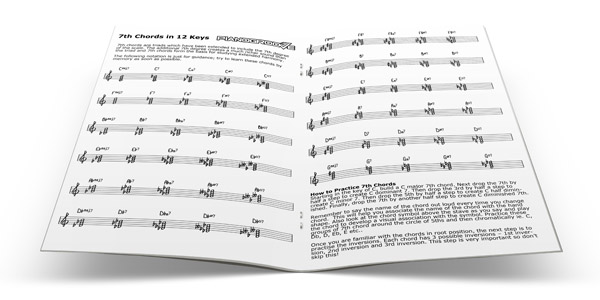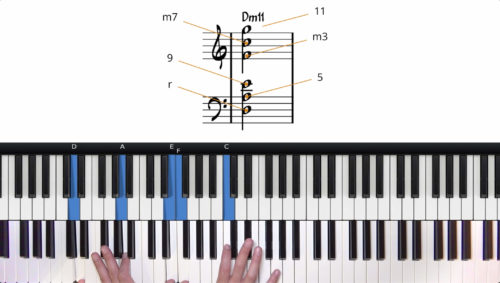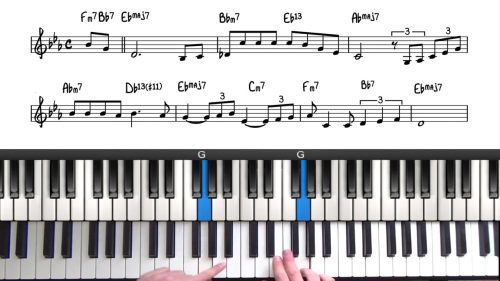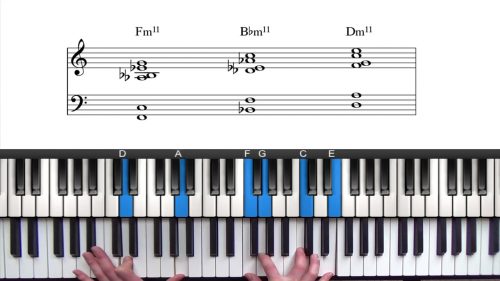7th Chords Tutorial For Jazz Piano
In this previous lesson of this course we explored triads for jazz piano. We are now going to take this a step further a build the 5 types of 7th chord.
A seventh chord is a triad which has been extended to include the 7th note of the scale. Seventh chords create a much fuller sound than triads and are used in jazz music to create richer harmonic progressions.
There are 5 main types of seventh chord that you need to learn – major, minor, dominant, half diminished and diminished.
The vast majority of chords you will come across in jazz will be one of these 5 chord types. Learning these chords and understanding their function in harmony is essential for building the major 251 progression which is the next step in your jazz piano journey.
Once 7th chords have been mastered we can add chord extensions on top of the 7th chord. The chord extensions include the 9th, 11th, and 13th and this is when our voicings start to sound very jazzy!
Downloadable Lesson Supplement
Major 7th Chords
First of all we have the major 7th chord. The major seventh chord is built by playing the 1st, 3rd, 5th, and 7th notes of the major scale.
The interval relationship is root, major 3rd, perfect fifth, major 7rd. In the key of C, the root of the chord is C, the major 3rd is E, the 5th is G and the major 7th is B. We can also build a major 7th chord from a major triad with a major third stacked on top.
Dominant 7th Chords
The dominant 7 is a very important chord. It has an unstable sound and wants to resolve to a major chord a fifth away. Dominant chords give movement & tension to a piece of music.
Dominant chords are built by playing the 1st , 3rd , 5th and flat 7th of the major scale. A quick way to build a dominant chord is to play the major chord and then lower the 7th note by half a step. We can also build a dominant 7th chord from a major triad and a minor third stacked on top.
The interval relationship of dominant chords is root, major 3rd, perfect 5th, minor 7th. It’s important to note the presence of the tritone interval in the chord. This is what gives the chord its unstable and tense harmonic quality. If you are unsure on what a tritone is, watch the lesson on intervals.
Minor 7th Chords
The minor 7th chord is built in the same way as the major 7th chord except we use the 1,3,5 & 7 from the natural minor scale. The interval relationship is root, minor 3rd, perfect fifth, minor 7th.
To find out the natural minor scale you simply take the major scale and lower the 3rd, 6th & 7th notes.
We can also build a minor 7th chord by playing the major 7th chord and then lowering the 3rd and 7th note by a half step. Alternatively, play the dominant chord and lower the third by half a step.
We can also build a minor 7th chord from a minor triad with a minor triad stacked on top.
Minor 7 b5 Chords
The minor 7 flat 5 chord, also known as the half diminished chord is most commonly used as the 2 chord in a minor 251 progression.
Minor 7 flat 5 chords are built using the 1, b3, b5 and b7 of the major scale. A simpler way to build a half diminished chord is to play the minor chord of the key and flatten the 5.
We can also build a minor 7th chord from a diminished triad with a major third stacked on top. The interval relationship of a half diminished chord is root, minor 3rd, diminished 5th & minor 7th.
Diminished 7th Chords
Finally we have the diminished 7th chord. Diminished 7th chords are the strangest sounding chords of those we have covered so far. A diminished chord is 3 stacked minor thirds so the interval relationship is root, minor third, minor third, diminished 7th
You could also look at diminished chords as a minor 7 flat 5 with a double flatted 7. We can also build a diminished 7th chord with a diminished triad and a minor third stacked on top.
The diminished chord does not have a definite tonal centre which makes them sound ambiguous. You can use this as a device to add tension to a piece and the resolve the chord.
The best thing about diminished chords is that you only have to learn 3 of them for all 12 keys as when you invert the chord it creates a diminished chord a minor third above.
Lesson Downloads
-
7th Chords In All 12 Keys File Type: pdf
-
Major Scale Diatonic 7th Chords File Type: pdf
Practice Tips
-
First learn to build these chords in root position in all 12 keys. This is the most important exercise to progress to the next stage of your jazz piano journey.
-
Don't worry about mastering all of the inversions in the short term... this is a gradual process, but at least try it with a few keys so you are able to visualise inverted 7th chords.
-
To invert a chord simply take the bottom note and put it on top. The bass note is now the third of the chord - this is what we call the first inversion.
-
Now invert the chord again by putting the lowest note on the top. The bass note is now the fifth of the chord - this what we call the second inversion.
-
Finally, you can invert the chord one more time (all four note chords can be inverted 3 times) The bass the note is now the 7th of the chord. This is what we call the third inversion. Note: if you invert the chord again you will be back at root position.














A good tip for learning these chords is to practice with your eyes closed. It really boosted my progression and emotional connection with different chords
Got a few questions if you could help me out? Up until now i have been practising all 5 types with both hands in root position and can pretty quickly go through the circle of fourths. Now that im trying to do the inversions, should i still be practising with both hands still? Because you only use your right hand in the video. If i am meant to learn them with both hands do you think it would be beneficial to learn with the right hand first and then add the left once I am comfortable knowing all the notes and shapes (which is basically what I did when I learnt the root positions around the circle). Also (and sorry for posting such a long series of questions), at the moment my practise routine basically only consists of going through the major and minor scales, and then going through the 7th chords as mentioned above. Should i be practising the major and minor 2-5-1’s yet? Because i feel like I should be able to play all these chords without thinking before I move onto that. Or even better yet, could you recommend a practise schedule for beginner who practices about 2 or 3 hours a day?
Hi Adam,
Sure thing, let me help you out here:
The essential theory is the 12 Major Scales, triads, and the different types of 7th Chords. If you don’t know these you should be practicing them every day until you have them memorised.
In the triads lesson and 7th chords lesson, I talk about practicing inversions. This takes a long time to get down in all 12 keys so don’t fret about it. It will come naturally with time, but the exercise i outline are also useful.
Always remember that with any of the theory, you will understand and retain it much better when applied in context of a jazz standard. This is why the jazz standard lessons are so important and are the crux of my teaching method.
Once you have an understanding of the basic scales and 7th chords, you will at least understand the foundations of what is being covered in jazz standard lessons.
Regarding your practice routine:
It’s very important that you are working on both the theory lessons, and the jazz standard lessons together. I’d recommend you split your practice time up, broadly split it in half, start with theory lessons and exercises, and then move onto jazz standards.
The jazz standards are the vehicle you use to apply the theory, and so when you see and apply it in context, it will make much more sense and you will retain the information much better than from theory drills.
I have received your email, and I will reply to you in length and outline a ‘road map’ for you to work through the material.
I’ll get this email over to you in the next 24 hours 🙂
Cheers, Hayden
This is very helpful. Thanks!
Thanks, glad you enjoyed the lesson 🙂
Hayden , believe me i subscribe because of you and how you reply to your members. thank you so much and happy new year.
I’m happy to hear that. Thanks for letting me know! 🙂
A very happy new year to you too.
Cheers, Hayden
At about 4:20 you do a minor 251 progression as an example Just wondering what these chords are please?
Hi Paul,
That’s a II-V-I in Bb Major, but I play a II-7b5 chord for C Minor, and a V7alt chord for F7.
The first chord is a C-7b5 in it’s 1st inversion, from bottom to top: Eb-Gb-Bb-C
Then we have a rootless F7#5b9 chord, from bottom to top: Eb-Gb-A-C# (notice that the top 2 notes from the previous chord move out a half step in either direction… that’s all that changes.)
I then play a Bb Major chord, with the root, 5th, 3rd and 9th spread across both hands.
Check out the lesson on the minor 251 here: https://www.pianogroove.com/jazz-piano-lessons/minor-251-progression/
Also this download will give you the minor 251 voicings in all 12 keys: https://www.pianogroove.com/resources/minor-251-progression-pdf/
Minor 251s are tricky to learn Paul.. so have some patience with them as it won’t happen overnight.
You can see lots of practice recommendations in the comment section of the minor 251 page.
Hope this helps and if I can be of further assistance just let me know 🙂
Cheers,
Hayden
Ah, I see. It was the #5b9 that confused me in the F7 chord. It’s a beautiful sound. Thank you kindly.
Hi there,
Thanks for great lessons. On this one the practice download doesnt seem to correspond to the lesson which was about the different types of 7th chords. The download is about Diatonic chords which havent been covered yet?
Hi Bjorn-Erik 👋
Well spotted!
Whilst we haven’t directly introduced the Major Scale Diatonic 7th Chords, I thought that this lesson would be a relevant place to introduce them. This lesson covers all of the 7th chords that you will find in major keys, and so you will now be able to identify each one of the diatonic 7th chords.
In every major key, if you build a 7th chord of each degree of the scale, we get the following 7th chords:
1st degree: major 7th chord
2nd degree: minor 7th chord
3rd degree: minor 7th chord
4th degree: major 7th chord
5th degree dominant 7th chord
6th degree: minor 7th chord
7th degree: minor7b5 chord
It could be a nice exercise for you to pick a few scales, and play the diatonic 7th chords for each. From watching this lesson, you should now have a basic understanding of how to construct and identify them. So the next step is to do this in context of the full scale. Perhaps just start with 1 key, and then move onto the next. Some keys are more common than others (such as Eb – which is a very common key for jazz standards) and so you will ‘get the most mileage’ out of learning this key first.
Next, I would recommend that you check out this lesson on the 1625 progression: https://www.pianogroove.com/jazz-piano-lessons/1625-436251-progressions/ – this is an intermediate level lesson, but one that I think you will find interesting. We talk about the diatonic 7th chords for each key, and explore how we can use them to create introductions and turnarounds for any tune we are working with.
The other lessons in that course then apply the theory to jazz standards: https://www.pianogroove.com/jazz-piano-lessons/intros-endings-turnarounds/ – there are some advanced arrangements here, but I think it’s good to attempt to learn them… “throw yourself in the deep end” ! Some of the theory might not make sense to begin with, but stick with it and it will make sense with time. It’s always good to push your knowledge and understanding…. I found that to be the fastest way to improve.
I hope this helps, if I can be of further assistance just let me know 🙂
Cheers!
Hayden
Thanks for another cracking lesson.
BTW in the PDF lesson supplement Major Scale Diatonic 7th Chords, the Cm7 chord which is
built on the 6th note of the E♭ major scale should (I think) read C E♭ G B♭ not C E♭ G B.
Am I the first to spot this?
Does a C7, for. example, denote the dominant 7th?
Yes that’s correct. When you see just “7” after the note name, for example, “C7”, “F7”, “Bb7”, “G7” etc… it denotes a dominant 7th chord which contains the major 3rd, and the b7. Dominant 7th chords are transitionary chords, ie. they always want to move (or resolve) somewhere. Usually a 5th down, ie C7 –> Fmaj7 or Fmin7, however, they can also be used as half step passing chords. Check out this lesson for more information: https://www.pianogroove.com/jazz-piano-lessons/slick-dominant-passing-chords/ Hope this helps and Happy Christmas! Hayden
one of my fave lessons – this is! That was a really fun and challenging lesson. I was playing along 🙂 liking the exercise tips you have provided. Thank you!
Awesome thanks for the feedback and glad you enjoyed the lesson!
Learning the inversions of these 7th chords is a gradual process and so don’t let this hold you back from progressing on through the subsequent courses.
In the final lesson of this course we cover the Foundations Practice Plan where I give more guidance on practicing the contents of this course. Check that lesson out and let us know if you have any further questions with the material.
Cheers, Hayden
Hayden, I,be recently felt confident enough to set myself the challenge of building 2-5-1 Progressions in all Major keys.Using the notes of a Major Scale (C Major) as the first Notes of the Diatonic Scales of C Major, I began. I felt a little surprised that the 4th note (F) in C Major , should in it’s diatonic transition to FMajor be flattened (,B flat) whilst all the others should be sharpened-2’ 3’ 5’ 6’7. The G Major Scale and D Major Scale were O.K. However, A Major Scale 7 note (G sharp) has an incomplete Diatonic Scale- unless you double-sharp C sharp E Major Scale 3 note G Sharp- requiring F double-sharp and C double-sharp in the Diatonic Scale. Please identify where I’m going so badly wrong. And please excuse the ineptness of my communication.
Hi, Hayden, a couple of things on seventh chords. In some of my music theory reading I have come across “minor-major” seventh chords comprised of root, minor third, fifth and major seventh. I have not seen them used all that much in songs or at least in the songs I like. Do these chords have a practical application in jazz piano? Also, in trying out chord extensions I noticed that a minor seventh chord in first inversion becomes a root position Major 6th chord of the second note of the minor seventh chord (in other words, Am7 in first inversion is a CMaj6, Dm7 in first inversion is an FMaj6 and so on. Similarly, Am7b5 in first inversion is a Cmin6 and so on. Any practical application to this relationship or is it just music theory trivia? At any rate, I find it interesting that the same notes can be combined to produce two different chords and in the first case I mentioned both a minor and a major type of chord.